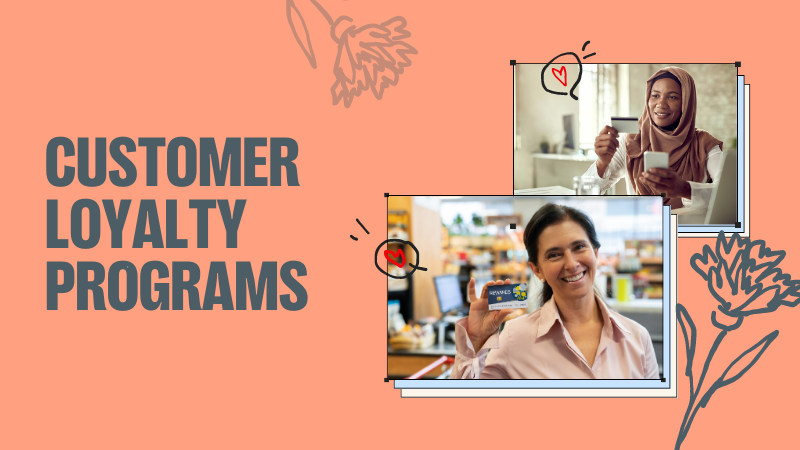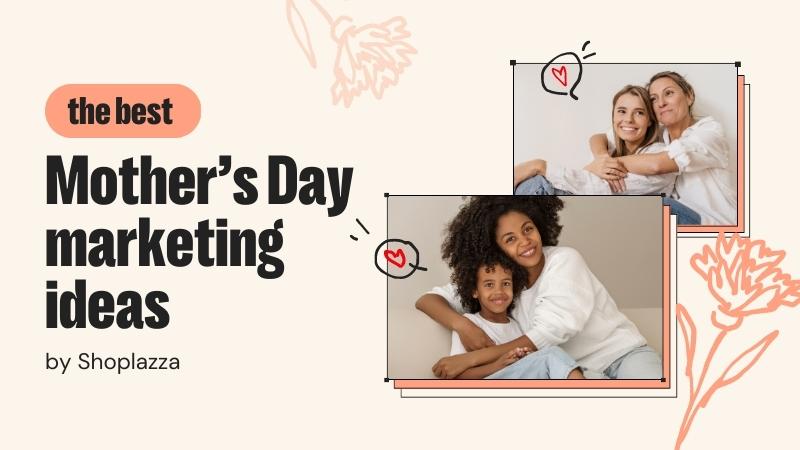Clothing is a high-margin, high-competition category in global e-commerce. Winning in this space takes more than style; it requires strategy. A direct-to-consumer (DTC) website gives you full control over your brand, pricing, and customer data. It also allows for higher margins compared to third-party platforms. But it comes with higher demands on planning and execution. This guide will explain how to make a clothing brand website from the ground up. It breaks the process into three clear phases—market strategy, website setup, and marketing, so you can build a brand that lasts, not just a store that sells.
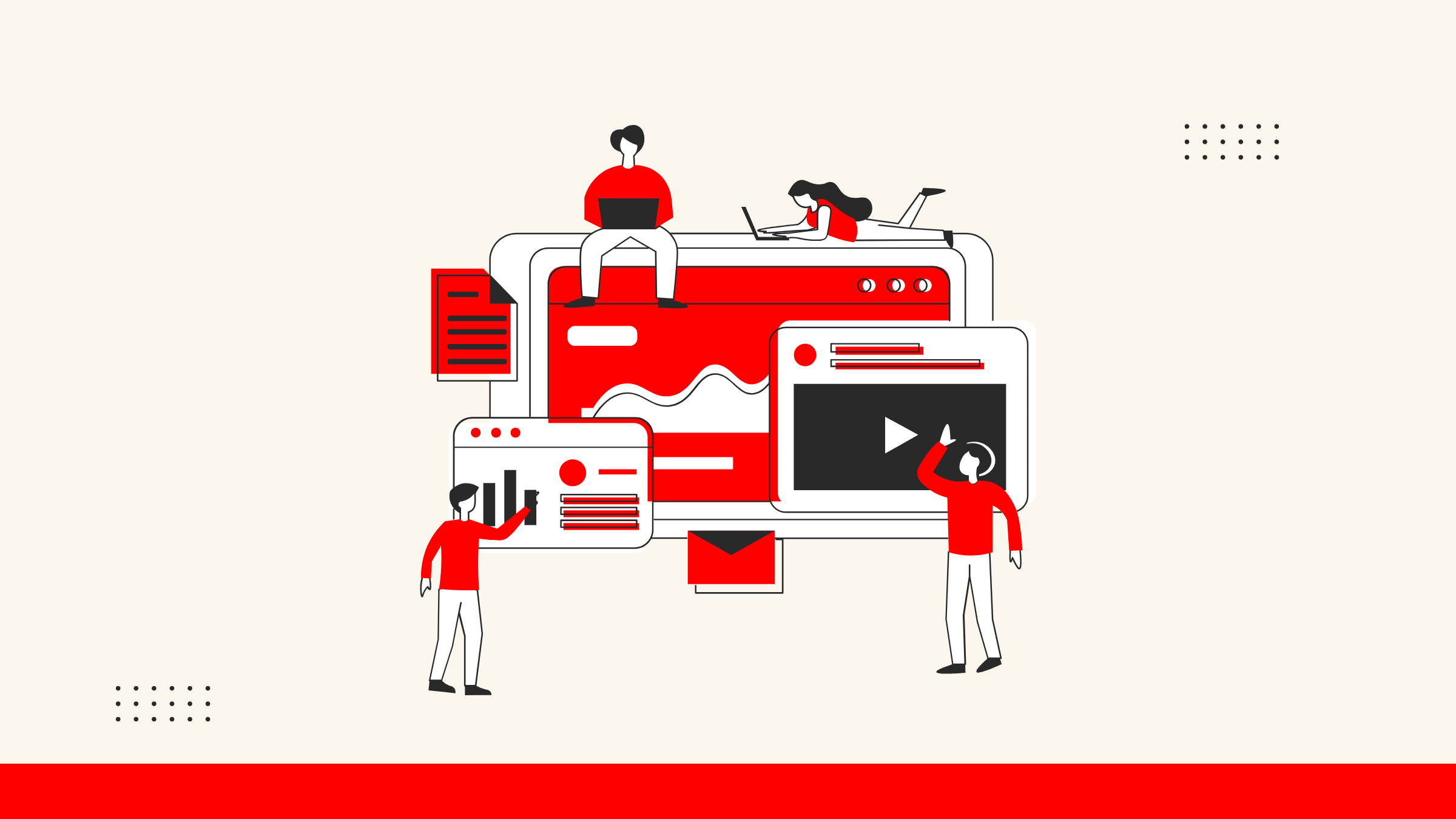
Phase 1: Define your market strategy
The first step in taking a clothing brand global is to define a clear market strategy, pinpoint customer needs, and lay the groundwork for product selection and operational planning.
Research clothing market
Market research is the foundation of any successful global expansion. For fashion brands, it directly informs product selection, brand positioning, marketing messaging, and pricing strategy. A well-researched market entry plan helps avoid costly missteps and ensures your offering aligns with real consumer demand.
-
Who are your target customers? What do they typically wear? What drives their purchases, and which channels do they use to shop?
-
How large is the market? What’s the annual growth rate? Is it a saturated space or a growing opportunity?
-
Who are your main competitors? How do they price their products? What does their product mix look like? What marketing strategies are they using?
-
What styles, materials, or functional features are trending locally?
Consumer preferences and shopping behaviors vary widely by region:
-
Southeast Asia has a young, fast-fashion-oriented audience that is highly price-sensitive. T-shirts, shorts, and athleisure dominate.
-
Latin America leans toward bold colors and expressive designs. Brand loyalty is strong, and women drive most of the purchasing decisions.
-
Europe and Japan are mature markets where customers prioritize fabric quality, accurate sizing, and sustainability. Long-term brand value matters more than short-term trends.
-
The Middle East, shaped by cultural and religious norms, favors modest designs with premium positioning. There’s significant growth potential in the luxury segment.
To reduce guesswork, leverage professional research tools and data platforms:
-
Competitors App: Track competitor activity across paid ads, SEO, social media, website updates, and email campaigns.
-
SEMrush / Ahrefs: Analyze competitor keywords, traffic sources, backlink profiles, and domain authority.
-
Brandwatch / Sprout Social: Monitor brand sentiment and customer conversations across social platforms.
-
Trustpilot / Google Reviews: Gather insights into customer satisfaction, service quality, and shipping performance.
-
McKinsey Apparel Reports: Explore deep market data on regional buying habits, average order value, and category trends.
-
Google Trends: Identify rising consumer interest in fashion segments like Y2K, techwear, or plus-size apparel.
-
Fit Analytics: Use AI-powered body data to understand size distribution and fit preferences in each market, improving both product development and inventory planning.

Coolie Nation in Trustpilot
Select product and business model
Product selection is the critical link between market demand and supply chain capability. It directly affects your brand’s ability to gain traction and scale. Once market research is complete, your product line and business model should be shaped by local consumer preferences, competitive dynamics, and sourcing strengths.
First, you may assess the competitive landscape to identify saturated categories versus untapped growth opportunities:
-
Red Ocean Markets: Basic T-shirts, yoga wear, leggings, and loungewear are highly competitive and heavily commoditized. Customer acquisition costs are high, and product differentiation is low. Success in these segments often depends on supply chain excellence and operational scale.
-
Blue Ocean Opportunities: Functional outdoor apparel, collections made from sustainable materials (e.g., bamboo fiber, organic cotton), custom-fit garments, Muslim women’s clothing for Middle Eastern markets (such as Abayas), plus-size fashion, senior-friendly apparel, and pet-themed collaborations are still under-served. These niches present room for differentiated entry and brand-led growth.

POD T-shirt example
After your product direction, choose a business model that aligns with your product features and resource capabilities:
-
Print-on-Demand (POD): It utilizes customization plugins ideal for personalized apparel such as T-shirts, hoodies, and jeans. Designs, text, techniques, and colors can be tailored. No inventory is required, as products are printed and shipped on demand. This model suits designer brands and social media-driven viral products.
-
Dropshipping: This model is suitable for fast-changing categories like women’s fashion, accessories, and activewear. No need to hold inventory, enabling rapid market testing. Common platforms and plugins include Pinji (supports Amazon product synchronization), CJdropshipping, and EPROLO.
-
Wholesale Purchasing: It best for standardized, price-stable basics such as camisoles and dresses. Products can be sourced from platforms like Soukuan, 17huoyuan, Yilianwang, and Huobutou, which support low minimum order quantities.
-
In-House Production + Direct-to-Consumer (DTC): It is tailored for original designer brands and high-value products. Production is managed through self-developed patterns and partner factories (e.g., Alibaba 1688, Huayi Network). Third-party overseas warehouses (such as Cainiao and 4PX) facilitate fast and efficient fulfillment.
Set price
An effective pricing strategy combines cost-based pricing, market comparison, and psychological pricing. When setting prices for cross-border clothing sales, consider the following factors:
-
Cost Components: Sampling fees, production costs, and packaging expenses.
-
Logistics Costs: Significant differences between air freight and sea freight.
-
Target Market’s Price Sensitivity: Know the psychological price point consumers are willing to pay.
-
Taxes and Duties: Include VAT, customs tariffs, and other applicable fees.
-
Brand Premium and Promotional Margin: Space to support brand positioning and marketing discounts.
For high-value, cost-effective products, adopting a three-tier pricing model is recommended: base price + shipping subsidy + first-time purchase discount. This approach helps improve conversion rates among new customers.
➡️ Learn More: Advance pricing management
Register a legal entity
Company registration is not mandatory for cross-border trade; individuals can also conduct transactions. However, for long-term, stable operations and scalability, a legal entity offers significant legal and business advantages to make a clothing website.
Common cross-border company structures include sole proprietorships, Limited Liability Companies (LLCs), and corporations. For example, U.S.-based LLCs are widely used because they support major payment platforms like Stripe and PayPal.
It is advisable to engage third-party service providers for registration to ensure compliance and efficiency. In early stages, operating under a domestic entity to access payment services is feasible, with the option to transition to an independent legal entity as business volume grows.
Register trademark
A trademark serves as a brand’s critical safeguard, protecting its intellectual property and market identity. The registration process typically takes about 12-18 months, though timelines may vary depending on examination progress and any opposition raised. The procedure includes search, application, acceptance, substantive examination, publication, approval, and issuance of the registration certificate.
A trademark with the United States Patent and Trademark Office (USPTO) typically costs between several hundred to a few thousand dollars. It depends on the type of application, the number of classes covered, and whether legal help is involved.
-
Filing Fees: The base fee is $350 per class for a standard application. Two application types exist: TEAS Plus, which has a lower fee but stricter requirements, and TEAS Standard, which is more flexible but costs more.
-
Legal Fees: Basic legal assistance may cost $400–$500 but often excludes thorough searches or rejection support. Full-service trademark attorneys charge between $1,000 and $2,000, depending on case complexity and experience.
-
Additional Costs: Extra fees may apply for amendments, multiple classes, and ongoing maintenance to keep the trademark active.
Phase two: 5 Steps to build a clothing website
Since you’ve finalized preparation, setting up your store becomes the next crucial step. Here are five essential steps to design a fashion website optimized for cross-border e-commerce.
Set up store info
You should choose a store name that is short, easy to spell, and easy to remember. Avoid using special characters or complicated words. The name should reflect your product category or brand style, allowing customers to quickly understand your offerings.
You should use a .com domain, as it is the most trusted and globally recognized extension. And you may keep the domain name consistent with your brand name to enhance search visibility and brand recognition.
You should also register the same name on key social media platforms. This will help protect your brand and ensure consistency across your online presence.
➡️ Learn More: 101 Guide to Domain
Upload clothing products
Traditional product upload methods often require manual entry of product titles, descriptions, and images. For sellers with large SKU counts, this process is time-consuming, error-prone, and inefficient.
You can simplify this process significantly with the Shoplazza platform:
-
You may use Excel or WPS spreadsheets to import product specifications in bulk, including titles, descriptions, inventory, and more.
-
If you already have a Shopify or Shopline store, you can seamlessly and quickly migrate your products via Store Migration plugin to Shoplazza, avoiding redundant data entry.
-
For Amazon sellers, you can install the Skuowner plugin to pull product information from Amazon and sync it to your independent store. This enables cross-platform sales with ease. If you use dropshipping, you can also push products from third-party platforms like CJdropshipping or EPROLO to your store, automatically updating inventory and order status, greatly improving operational efficiency.
➡️ Learn More:
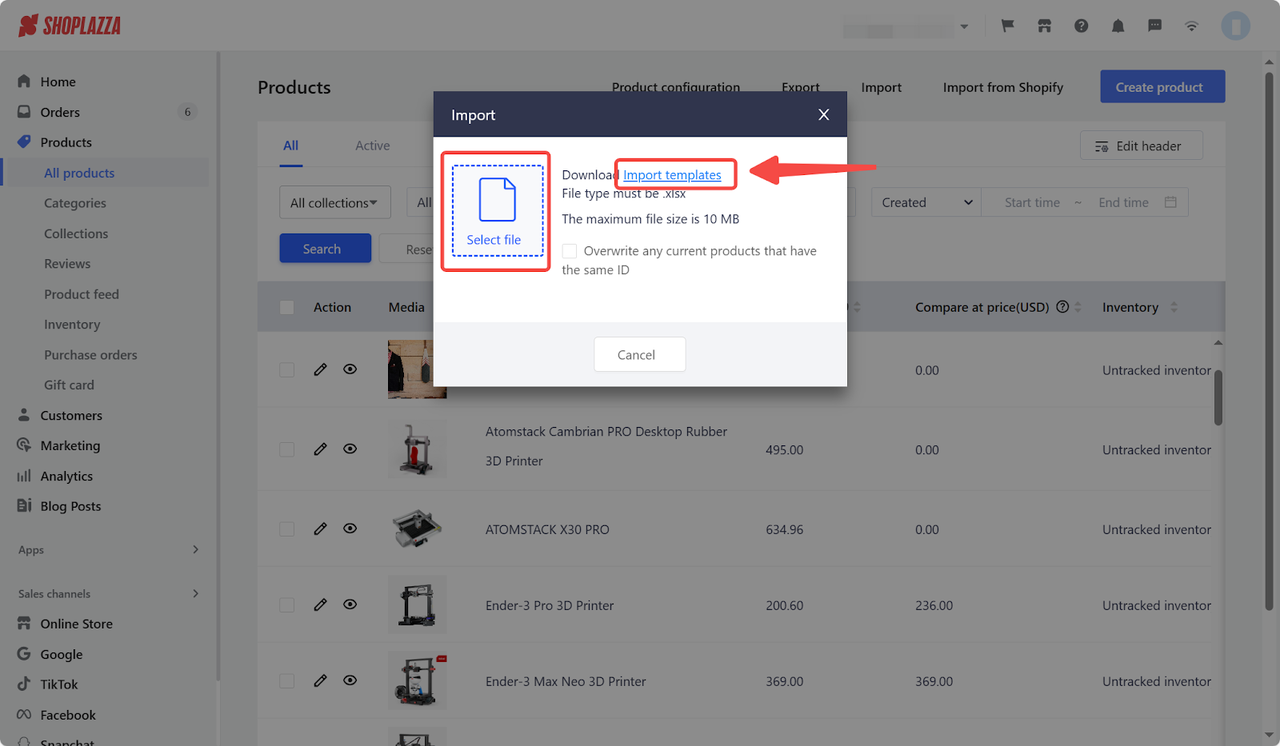
To showcase your brand’s identity, you may prepare clear product images, lifestyle shots, videos, fabric close-ups, and styled model photos. And you may pair these visuals with cohesive, persuasive copy to highlight key features like fit, material, and design. This approach boosts professionalism and significantly improves conversion rates.
Once you have uploaded your products, choose a suitable clothing store design template. The Nova theme on Shoplazza is widely used for stores with lots of SKUs and various product categories. It is ideal for shops that require extensive promotional displays. The template also supports complex navigation, tag filtering, and marketing components, making it a great option for multi-category clothing sellers getting started.
Configure payment methods
Payment methods directly impact conversion rates and customer experience. You need to offer diverse options that align with your target market’s preferences. For example, consumers in the U.S. and Europe prefer credit cards and PayPal, while Southeast Asia favors e-wallets and local bank transfers. In Latin America, installment payments and local cash options are more common.
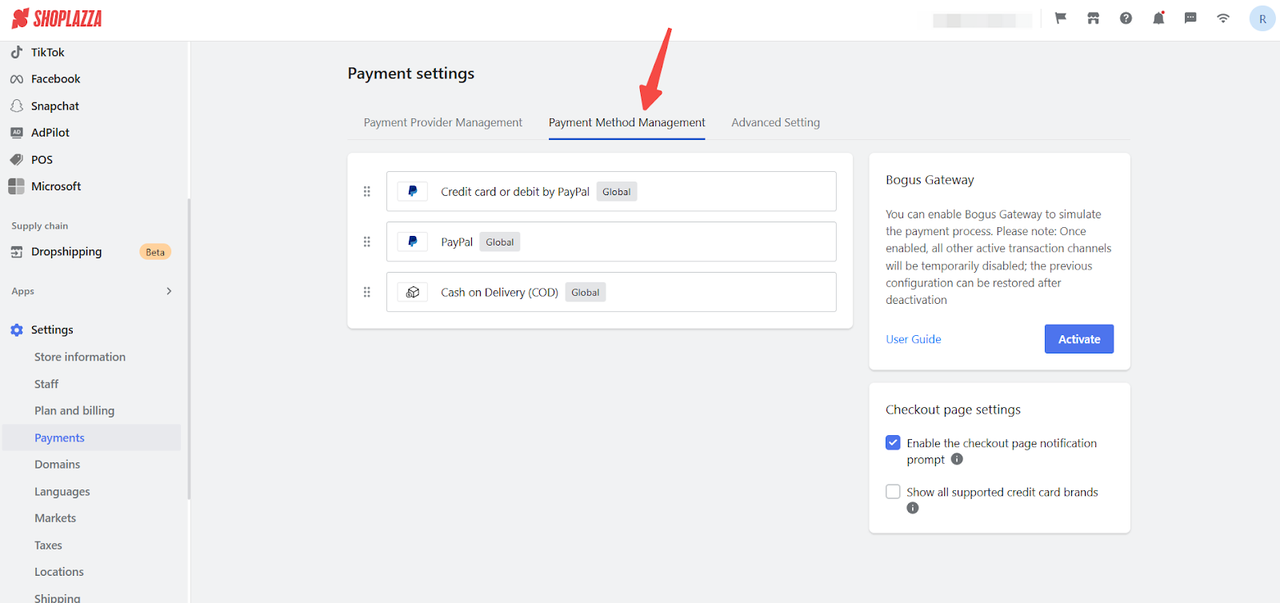
Currently, Shoplazza supports over 180 global payment methods, including:
-
Credit/Debit Cards (Visa, MasterCard, American Express, etc.)
-
E-wallets (PayPal, Apple Pay, Google Pay)
-
Local payment methods (Klarna, iDEAL, PIX, GrabPay, etc.)
-
Installment payment options to increase the success rate of high-ticket sales
You can also configure currency settings, tax rules (e.g., EU VAT or U.S. state sales tax), billing cycles, and reconciliation accounts in the backend, ensuring financial clarity and compliance. This helps streamline future advertising campaigns and refund processing.
➡️ Learn More:
Choose shipping methods
Logistics is a crucial element in cross-border clothing retail, directly affecting customer experience and repeat purchase rates. Choosing the right shipping method can optimize costs and improve delivery efficiency. Here are some common cross-border shipping options:
-
Overseas Warehousing: Ship products to warehouses in target countries beforehand. When customers place orders, goods are shipped locally, reducing delivery times and increasing customer satisfaction. Ideal for products with steady sales.
-
Self-Shipping: Manage inventory and shipping yourself. Suitable for new brands with small order volumes. Flexible but time-consuming, and challenging to scale as orders grow.
-
Third-Party Fulfillment (3PL): Outsource warehousing and delivery to logistics companies. Perfect for rapidly growing brands, offering scalable operations and real-time order status synchronization for better efficiency.
To streamline order fulfillment, Shoplazza integrates with over 50 logistics providers, such as Aftership. Once orders are generated, you can input tracking numbers, enabling real-time updates for customers and enhancing post-purchase experience.
Launch and test
The launch phase is critical for validating and refining your international strategy. Since website creation often relies on templates and industry standards, it’s unlikely to be perfect from the start. Multiple rounds of testing and optimization are essential before and after the launch.
Before launch, ensure all elements, such as copy, payment systems, and mobile responsiveness, are checked to avoid any technical issues that could affect user experience.
After launch, the real testing begins. Continuous testing and adjustments are required to tailor the website to market demands:
-
A/B Testing: Test two versions of a page to see which one performs better. For example, in the U.S., version A might feature a “limited-time discount countdown,” while version B showcases “free shipping.” In Southeast Asia, version A may use simple product images, and version B could feature a video carousel, evaluating which gets more clicks.
You can use tools like Google Optimize, Hotjar, and Microsoft Clarity for A/B testing and user behavior analysis to improve website performance. Use these insights to adjust homepage banners, optimize product categories, or simplify the checkout process to improve conversions.
Phase 3: Marketing and promotion
The success of your marketing phase determines whether your brand truly reaches the market. Effective promotion not only drives traffic but also converts it into sales, propelling business growth.
Given the significant cultural, aesthetic, and consumer preference differences across markets, you must focus on both language and behavioral localization. Additionally, adjust your visual presentation and communication style to align with local consumer habits. The right marketing channels and strategies are critical. Here’s a breakdown of common marketing strategies:
SEO
You can enhance your website’s ranking on search engines like Google through SEO, including keyword research, content optimization, and link-building. Research long-tail keywords in your product categories, write blogs, optimize category pages, and improve product descriptions. Use tools like Google Analytics and Google Search Console to continuously monitor performance and adjust strategies.
SEM
You may leverage paid advertising on platforms like Google Ads and Facebook Ads to acquire targeted traffic. Focus on precise audience targeting to improve conversion rates. Tailor your ads around local holidays or promotional periods. For example, in Latin America, capitalize on strong purchase intent during Singles’ Day and boost ROI through timely promotions.
Social media marketing
You can select social media that best suit your target market, like Facebook and Instagram, TikTok, and Pinterest, to share visually compelling content and brand stories. Collaborate with local influencers or KOLs (Key Opinion Leaders) to amplify your brand's presence. Encourage user-generated content (UGC) to foster a sense of community and build trust. For example, Michael Kors’ #WatchHungerStop campaign merged fashion and social impact, while Gucci’s AR experience on Instagram and TikTok featured their Virtual 25 sneakers, blending the fashion world with the metaverse.
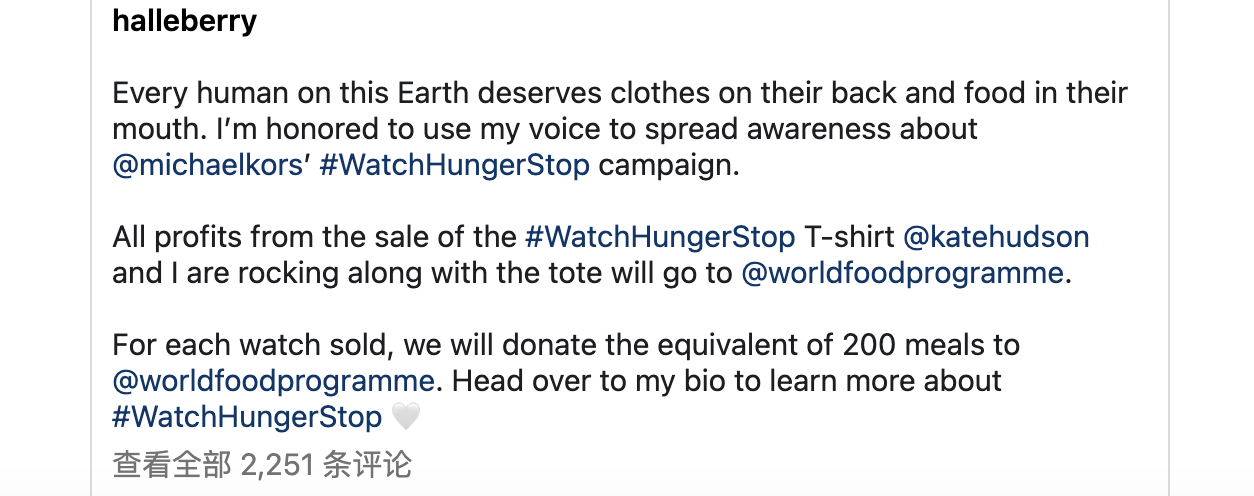
Source from influencermarketinghub
Email marketing
What's more, you may maintain customer engagement through personalized email campaigns that promote new products, sales events, and abandoned cart reminders. Use urgency, social proof, and limited-time offers to improve open rates and conversions. Then, use your email subscription list continuously to build a reliable communication channel with customers. For instance, Everlane reminds customers of restocked popular items while highlighting the investment value of their classic pieces. Gymshark, on the other hand, attracts customers by showcasing style recommendations with humorous copy, keeping the tone light and engaging.
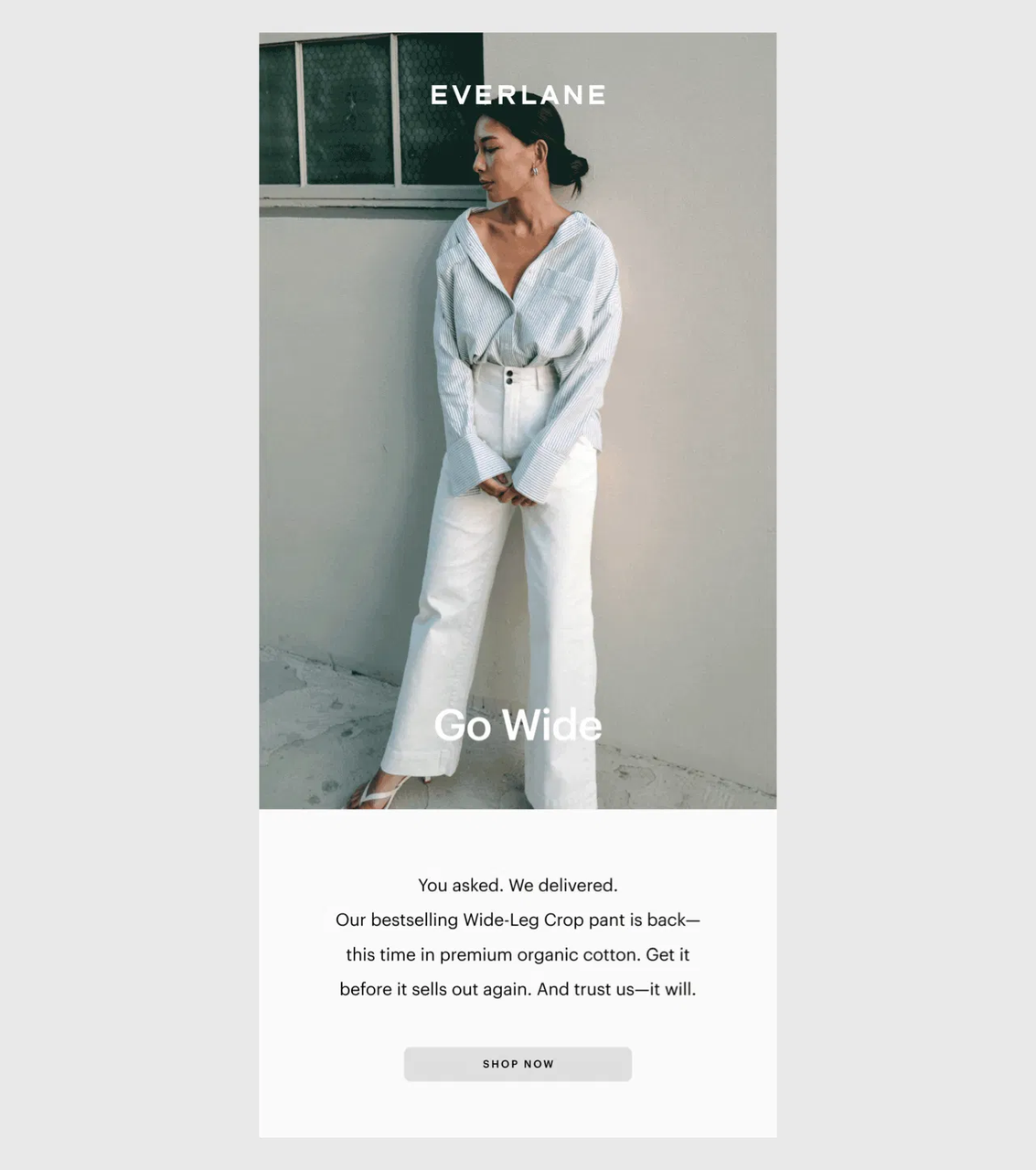
Source from getsitecontrol
➡️ Learn More:
Start your clothing brand store
How to make a clothing brand website? Is it hard? It seems easy with the right tools and platforms. With the right resources, like Shoplazza, you can design a professional clothing store that’s ready for the global market. From product management to marketing integration, these platforms simplify every step, making it much easier to launch and grow your brand online. Start today and turn your vision into reality.

